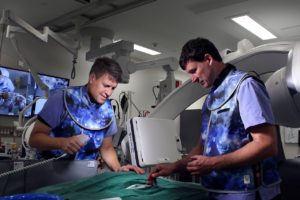X Marks Another Boost For Radiation Therapy Research

Radiation therapy research and medical imaging could soon be further revolutionised after the launch of the Australian Cancer Research Foundation (ACRF) Image X Institute.
The multi-million dollar institute, based at the University of Sydney, will focus on creating medical devices for cancer imaging and targeted radiation therapy.
Funded by $2.5m from the Australian Cancer Research Foundation and a further $25 million in research support, the institute will also help unite experts from various fields to advance the science and clinical practice of cancer treatment.
Institute director Professor Paul Keall, who will help lead the institute alongside top professionals, researchers and collaborators, said he was eager to start the potentially ‘phenomenal’ work of the institute.
“Our mission is to create, share and apply scientific knowledge to improve human health,” Prof Keall, who is based at Sydney Medical School at the University of Sydney, said.
“We will revolutionise medical imaging, transform functionally targeted radiotherapy and enable global access to radiotherapy.
“With world class expertise in bench-to-bedside translational research, an entrepreneurial focus and cross-disciplinary collaborations, the Institute will attract top tier researchers with a track record of pioneering technology.”
The $2.5m funding from the ACRF is supporting three unique cancer imaging and targeted radiotherapy devices, which are aimed at further advancing patient connected imaging.
“By improving treatment accuracy of radiation therapy, patients will enjoy improved outcomes and also reduced side effects of radiation therapy treatment,” Prof Keall said.
“We are using the institute platform to accelerate the transfer of technology from the institute to hospital, making that treatment more widely available to cancer patients in Australia.
“We can use the effects of technology to reduce side effects of treatment, make that treatment more accurate and improving the quality of diagnosis of cancer.”
The institute currently has 270 papers published in top international journals, with six clinical world-firsts in research discoveries and technology and 13 clinical trials taking place in Australian hospitals.
Prof Keall cited the example of the SPARK trial, which has helped reduce treatment time for prostate cancer patients at Sydney’s Westmead Hospital, as an area where research in medical imaging has produced better outcomes for cancer patients.
He said the launch of the institute was another potentially big step in continuing efforts to provide improved cancer treatment.
“There are cancers that are incredibly aggressive and challenging but we can look at some of the successes of radiation therapy treatments, for example early stage lung cancer and prostate cancer,” he said.
“Cancer is still unfortunately killing many people, but we can see the benefits of proper treatment and there is huge potential for future improvements to help patient outcomes.
“There’s some phenomenal work being done by dedicated people in the treatment of cancer. Patients are benefiting by what we have done, which is an incredible feeling.”
For more on the work of the ACRF, click here.
For more on how radiation therapy helps with the diagnosis and treatment of cancer, click here.




